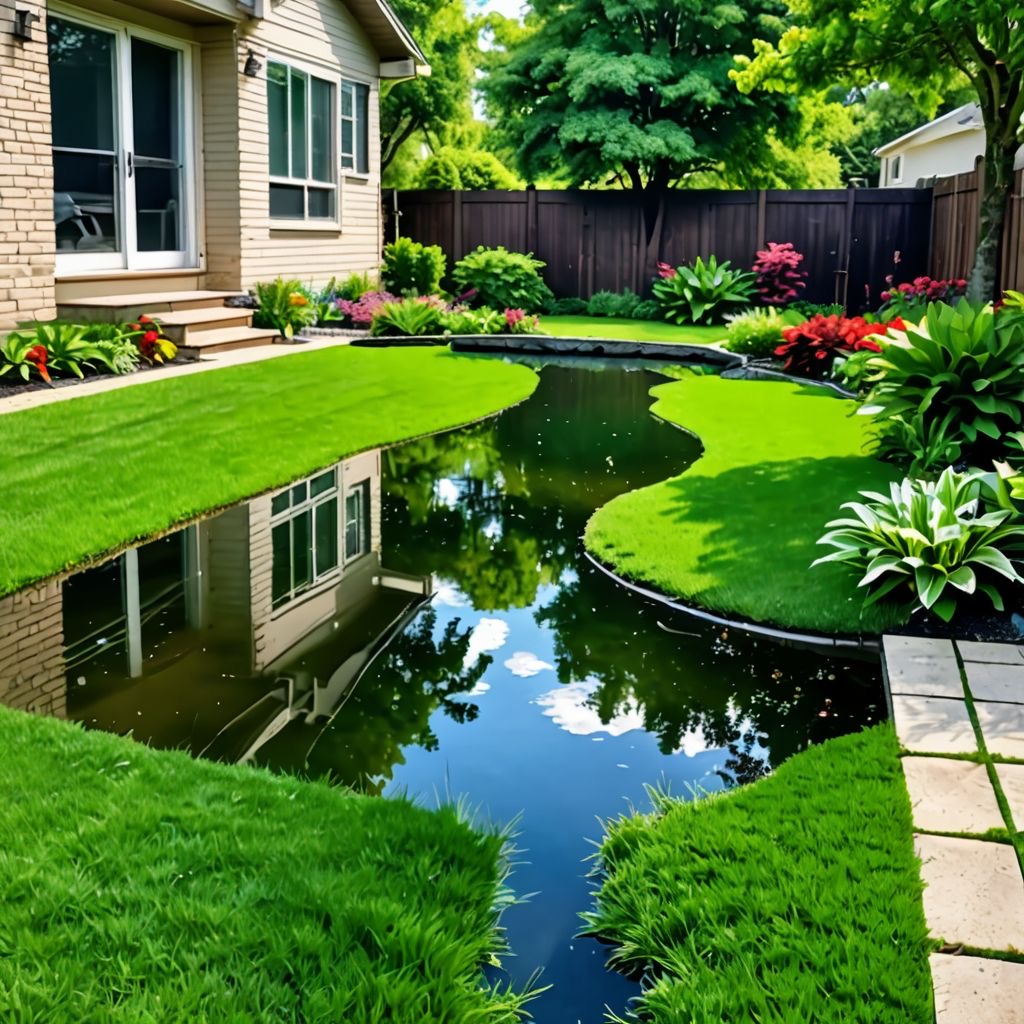
Table of Contents:
1. Introduction
2. What Makes a Healthy Lawn?
3. The Role of Sand in Lawn Care
4. Types of Sand Recommended for Lawn Improvement
5. How Much Sand Should You Use in Your Landscape?
6. Application Techniques
7. Expected Results of Using Sand on Your Lawn
8. DIY Lawn Sanding vs. Hiring a Professional Lawn Care Company Near Me.
9. Conclusion
1. Introduction
When it comes to yard care, many of us have good intentions. Whether you’re the proud owner of a sprawling backyard in Winnipeg or managing a small plot of grass that seems to have gotten a little out of hand, the journey towards a lush, green outdoor carpet often feels like an uphill battle.

You may have tried everything from organic fertilizers to specialized weed control, and yet, the quest for that perfect green continues. Here’s where the age-old question pops up: “Is it a good practice to use sand to improve your grass?"
Before you roll your eyes and picture a mound of beach sand being dumped onto your green space, let’s talk about how it can be an essential ally in the journey toward a healthier yard.

This material isn’t just about aesthetics; it can enhance soil quality, improve drainage, and help cultivate a vibrant dose of greenery. However, before you break out the shovel and start heaping it atop your beautiful sod, it’s important to understand what you’re getting into.
In this engaging and informative essay, we’ll dive deep into the nitty-gritty details of incorporating sand into your yard maintenance routine. We’ll explore the types that work best, the ideal quantities to use, how to apply it properly, and the kinds of results you can expect. We'll also tackle the age-old debate of DIY versus hiring a professional service. Trust us; by the end of this article, you’ll be equipped with all the knowledge you need to make an informed decision about whether adding this material is the secret sauce your landscape has been craving!
2. What Makes a Healthy Yard?
Before we dig into the topic at hand, let’s establish what a healthy yard means. At its core, a thriving outdoor space is a complex ecosystem that includes soil, grass, and beneficial microorganisms. It should be lush, green, and resilient enough to withstand foot traffic, pets, and variable weather conditions.
A few vital components that contribute to a healthy garden include:
- Soil Composition: Healthy soil must strike a balance between sand, silt, and clay—a concept often referred to as the “soil triangle.” This balance promotes good drainage while retaining necessary nutrients and moisture.

- Nutrients: Your grass will not thrive without sufficient nitrogen, phosphorus, and potassium. Many residents in Winnipeg are turning towards organic yard care methods that utilize natural fertilizers to boost soil nutrient content.
- Aeration: This process involves perforating the soil with holes to ensure air, water, and nutrients can penetrate down to the roots. Promoting aeration enables grass to grow deeper and stronger, ultimately leading to a more robust garden.
- Mulch: By applying mulch, you can retain moisture and suppress weeds—two critical factors for maintaining a green outdoor space.
Regular maintenance practices like mowing, fertilizing, and pest control also play a crucial role in keeping your greenery looking its best. When all these elements come together, you cultivate a healthy habitat that enhances curb appeal and provides a beautiful outdoor area for family and friends.

3.The Role of Sand in Lawn Care:
So, how does this material fit into the well-oiled green machine? Adding sand has several roles in yard maintenance, making it a valuable addition when utilized correctly. Here are some significant benefits of using sand:
1. Improved Drainage: If your garden suffers from poor drainage or water pooling, this material can be a savior. When mixed with clay-heavy soils, it enhances drainage, thereby preventing water from sitting on the surface and promoting healthy root growth.
2. Aeration Support: In areas with compacted soil, adding sand helps break up hardened layers, facilitating air and nutrient infiltration that leads to robust grass health.
3. Soil Structure Improvement: Sand increases air spaces within the soil, ensuring that grassroots can breathe while also retaining essential moisture.
4. Balanced pH Levels: Certain types, like limestone sand, can adjust the pH level in overly acidic soils, creating a more hospitable environment for growth.
While these benefits highlight the positive aspects of incorporating sand into your care routine, it’s essential to remember that not all types are suitable. Let's look at the different varieties that can impact your space positively.
4. Types of Sand Recommended for Lawn Improvement:
Not every type of sand will do wonders for your greenery! When it comes to choosing which to use, look for material that meets specific criteria for enhancing soil. Here are some types commonly recommended by landscaping professionals:
1. Sandbox Sand: Fine, clean sand typically used in children’s play areas. While it may not suffice on its own, it can be mixed with other materials for better results.
2. Construction Sand: A coarser option commonly used in landscaping projects, it aids in drainage when mixed with existing soil, though make sure to check its salt content to avoid harming your plants.
3. Silica Sand: A popular choice for those wanting to enhance aeration and drainage. This cleaner option minimizes contamination concerns.
4. Limestone Sand: Excellent for raising pH levels in acidic soils and providing essential nutrients, it also improves soil texture.
5. Topdressing Sand: Specifically formulated for topping off lawns, this can be mixed with compost for optimal results.
Choosing the right type is crucial for achieving your desired outcome. Consulting local lawn care companies or professionals in Winnipeg is always wise to ensure you're making informed choices based on your specific yard conditions.
5. How Much Sand Should You Use in Your Landscape?
Great, you've picked your ideal material and are eager to get started! But before you dive in, it’s essential to answer: How much should you use for effective improvement?
As a general guideline, most experts recommend applying about ¼ inch of sand across your entire yard. This quantity maximizes benefits while preventing your grass from being smothered.
6. Application Guidelines:
- Soil Testing: Before adding sand, consider conducting a soil test to determine its texture and composition. This assessment assists in deciding whether additional amendments like organic fertilizers are necessary.
- Frequency of Application: It’s generally advisable to top-dress your greenery with sand once a year, especially in conjunction with other lawn care practices like aeration and seeding.
- Mixing with Organic Matter: For optimal results, think about blending sand with organic matter like peat or compost. This mix not only promotes excellent drainage but simultaneously enhances soil fertility, creating a win-win scenario for your grass.
Excessive application of sand can create a barrier that prevents moisture retention, which can adversely affect your grass. A gradual approach, based on what your yard needs, will help you achieve the vibrant greenery you desire.
Ready to chat about your landscaping goals?

Reach out by call or text to: 204-229-9789 or click here to submit your information today to arrange a “no obligation” introductory phone call. We look forward to helping you transform your yard.
Tips on how to prepare for a consultation meeting with a landscape contractor
6. Application Techniques:
Now that you've chosen the right sand type and gathered adequate quantities—what's next? Application techniques play a crucial role in ensuring your yard reaps the maximum benefits of the material. Here are some practical steps for effective application:
6.1 Mow Before You Start
Cut the grass short to about 2 to 3 inches in height to avoid burying it in sand. This way, the material can blend in better, allowing your grass to absorb its benefits.
6.2 Water the Yard
Prior to applying, consider lightly watering your lawn. This negates excess dust and keeps the material from clumping.
6.3 Distribute the Sand Evenly
Using a shovel, sand spreader, or wheelbarrow, distribute the sand as evenly as you can. Working in sections will help ensure full coverage.
6.4 Rake it In
Once you’ve spread the material, rake it into the grass and soil. This incorporation helps ensure it makes contact with the soil beneath, which promotes better drainage and aeration.
6.5 Follow Up With Watering
After incorporating the sand, thoroughly water your yard. This step encourages the sand to settle and fills any air pockets created during the application.
6.6 Maintain Regular Care
After adding sand, continue standard maintenance practices, including weekly grass cutting and applying organic fertilizers. Your grass will need some tender loving care to adjust to its new environment!
7. Expected Results of Using Sand on Your Lawn:
After all that work, what should you anticipate? If applied correctly, using sand can lead to several positive transformations in the health and appearance of your green space over time:
7.1 Enhanced Drainage: You should see improved drainage and a reduction in puddles and standing water, especially in regions prone to waterlogging.
7.2 Better Aeration: As grass roots grow deeper and more robust, you can look forward to lush greenery with a healthy sheen.
7.3 Improved Soil Texture: Your soil will become less compacted, thus promoting healthier growth overall.
7.4 Increased Nutrient Availability: By combining this application with organic lawn care methods, you’ll find nutrients from fertilizers penetrating more deeply into the soil, resulting in more vibrant grass.
7.5 Overall Health Boost: Ultimately, your landscape may become more resilient against pests and diseases, thereby minimizing the relentless battle against weeds.
However, it’s important to note that results won’t appear overnight. Grass needs time to adjust and respond, so allow several weeks to gauge its progress.
Transform your Winnipeg yard. When it comes to lawn care Winnipeg homeowners trust, Sunshine has earned a solid reputation.
6. DIY Lawn Sanding vs. Hiring a Professional Lawn Care Company Near Me:
The next big decision you may face is whether to tackle this project yourself or to enlist the help of a local lawn care company. Let’s break it down:
DIY Sanding
Pros:
- Cost-Effective: Doing it yourself can save you money compared to hiring professionals.
- Expert Learning: You’ll acquire valuable lawn care experience that pays dividends in the future.
- Control Over Process: You control the timing and methods, allowing for a customized approach.
Cons:
- Labor Intensive: Lawn care can be physically demanding and time-consuming, depending on the size of your yard.
- Possible Trial and Error: Without adequate knowledge, your efforts may lead to mistakes that can yield poor results.

Hiring a Professional

Pros: Expertise at Your Service: Professionals possess the knowledge to assess specific yard needs and can apply techniques tailored to your green space.
- Time-Saving: You won't have to spend weekends shoveling and spreading materials!
- Guaranteed Results: Many local companies stand by their work; if an issue arises, they will make it right.
Cons:
- Higher Costs: Often, hiring professionals necessitates a larger investment, which may be beyond your budget.
- Less Personal Touch: You may miss out on learning about your yard through DIY engagement.
In many cases, it’s best to start with a DIY approach if your yard is small and you feel comfortable with some manual labor. Conversely, if your outdoor area is extensive or requires specialized knowledge, hiring a professional may be the smart choice.
9. Conclusion:
Whew! If you've made it this far, congratulations—you’re now equipped with valuable knowledge about improving your yard! Whether adding sand is a beneficial practice ultimately depends on specific conditions and your goals. With the potential to improve drainage, aeration, and nutrient absorption, it can be a useful tool when applied correctly.
To recap, remember that proper application techniques, the right type of material, and diligent follow-up are crucial for achieving that dream landscape. Don’t hesitate to consult local Winnipeg lawn care services if you’re ever in doubt about your method.
From enhanced drainage to improved aeration and overall health, the potential changes can make anyone excited about their grass's future. It’s all about achieving a flourishing outdoor space that you can proudly showcase!
So, are you ready to roll up your sleeves and get to work? Or will you seek the assistance of professionals nearby? Whatever the choice, here’s to your yard thriving and becoming the envy of all your neighbors!
Don't miss out! Click here to subscribe today and get the latest blog posts delivered straight to your inbox.



